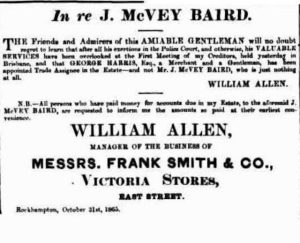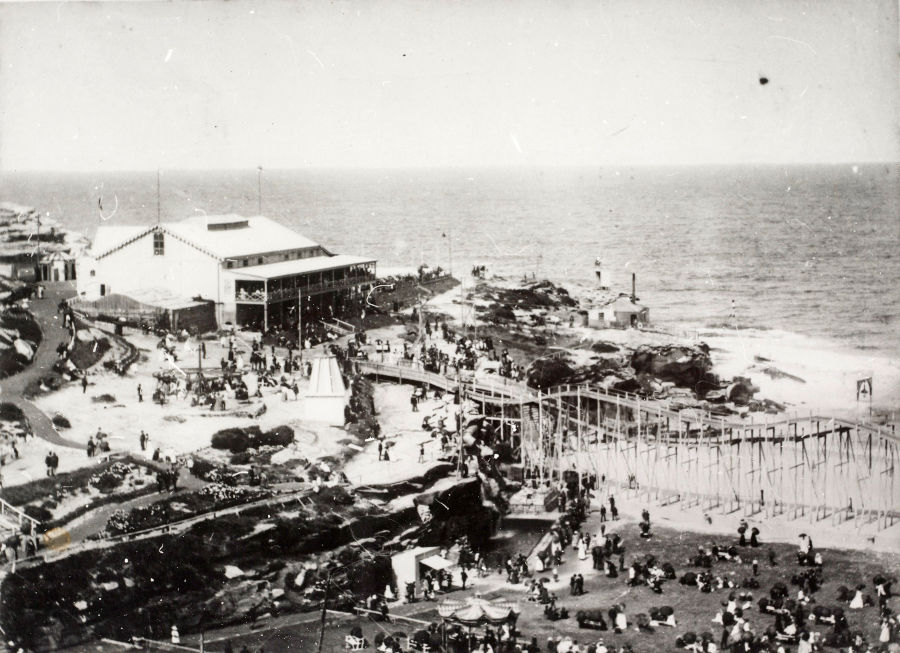Profession: Accountant
Members of the Baird family lived at today’s 268 Glebe Point Road for over seven decades. Their house, called Eglinton, was demolished in 1968 and home units now cover the site. The present building next door at Number. 270 dates from 1891, replacing another which was Eglinton’s twin. The addresses were fixed by 1906.
Eglinton’s first occupiers
In 1846 chemist and druggist Charles Marcian Penny bought four lots on Glebe Road on which he built two stone shingle-roofed six-roomed houses with verandahs and a natural water supply. The villas and their added storeroom, servants’ room, coach house, hay loft and stable were set in ornamental gardens with views to Johnstons Bay. A tennis court was later built on the site.
Penny died in 1857 and the next year both houses were leased to clergyman John Pendrill for his Anglican Collegiate School for boys. Educated at Eton and Oxford University and a champion chess player, Pendrill stayed with architect Edmund Blacket at Bidura until the buildings were ready for occupancy. The college’s initial intake of two expanded to 70 boarders and day pupils including Glebe locals Cyril Blacket, William Boyce Allen and cricketer Fred Spofforth ‘the demon bowler’. John Fowles taught drawing. In 1869 Pendrill had a serious fall from his horse. He died three years later at his home Eglinton House and was buried in Balmain Cemetery.
Pendrill’s successor Thomas James Bowyer found the house and schoolrooms too small and in 1878 the school moved into a new two-storey building with views from its upper balconies and windows as far as Pennant Hills. The move was injudicious however and within a year Bowyer was declared insolvent. He died in San Francisco in 1880. The school was then converted into Sydney’s first children’s hospital. Glebe Library now stands on the site.
Atkinson Alfred Patrick Tighe lived at Eglinton House during a short break from politics. Police magistrate, MLA for Northumberland and a friend of Henry Parkes, Tighe died in 1905 at Ravensworth 220 Glebe Point Road and was buried in Waverley Cemetery.
Members of the importing firm Myers and Solomon were Eglinton’s next occupiers. Their George Street emporium sold everything from hardware, crockery, jewellery and perfumes to sporting goods, musical instruments, art works and saddlery. The founders’ professional partnership had been cemented by the 1855 marriage of George Myers to Sarah Solomon at the York Street synagogue. Sarah was the eldest daughter of Mordecai and Elizabeth Solomon of Strawberry Hills. The latter died aged 43 in 1852, leaving a widower and eight children, and was buried in the Devonshire Street Cemetery.
The Myers couple lived at Brickfield Hill, Woolloomooloo, Strawberry Hills and Millers Point before moving to Eglinton where George Myers died in March 1882, survived by his widow and 13 children. A life member of the Hebrew Philanthropic Society, he was buried in the Jewish cemetery at Rookwood. The following year, Sarah’s father 83-year-old Mordecai died in the house, as did her uncle-in-law Wolf Myers, a 54-year-old Mason in October 1886. Sarah herself passed away there in January 1890 aged 53, and was buried at Rookwood. The executor was her eldest son Mark Myers. Board and residence were advertised for country visitors at what was then numbered 202 Glebe Road, accessible to the city every few minutes by omnibus, tram and steamer.
The Baird family
The entrepreneurial John McVey Baird, who had survived a series of bankruptcies in Australia and New Zealand, moved into Eglinton in 1891. His time in Glebe was the longest he had ever lived in one place and, past business failures forgotten, he involved himself in local affairs. When he registered on the Commonwealth electoral roll, he described himself as an accountant, as did his brother Robert who lived in the same house. Other occupants in the period 1906 to 1913 included John’s wife Eleanor, their daughter Lucy Eliza, book-keeper son Harold Robert and his wife May Glanville née Goodall, and John William Baird, a clerk. At the turn of the century John, Robert and Harold were also listed at 1 Mary Street.
John McVey Baird was born in 1832 at St Cuthbert’s, Edinburgh, Scotland, to Elizabeth and John Baird. His siblings Robert and Andrew Smith Baird were born in 1834 and 1836 respectively. By 1853 the Baird Brothers were trading in Melbourne as importers of spirits and foodstuffs. The next year John McVey withdrew from the partnership, his estate having been sequestered, leaving the running of the firm – renamed John Baird and Son – to Andrew Smith Baird. John McVey then surfaced as Secretary of the St Andrew’s Mining and Sluicing Company looking for shareholders. Andrew Smith served a gaol sentence in South Australia in 1858 and the next year, his profession corn dealer, was declared insolvent in that State. In 1861 – a year after marrying Eleanor Laidlaw Thompson, the daughter of a Manchester solicitor – John McVey too was declared insolvent, in Victoria.

Andrew married Eleanor’s younger sister Elizabeth Laidlaw Thompson in New Zealand in 1863. By then all three brothers were trading as Baird Brothers in Dunedin, and in debt. In 1865 John McVey’s name came up in the Rockhampton Insolvent Court, Queensland, in connection with the estate of William Allen who published a series of denials that the man was his Trade Assignee. Four years later, John McVey, trading as printer and publisher Baird & Co., was declared insolvent in New South Wales. Meanwhile, McVey, Baird and Co. publicised itself as sole Australasian agents for L’Extincteur, a portable fire engine, and arranged public demonstrations of its efficacy in the Sydney Domain.
Eleanor and John McVey’s first child Herbert McVey was born at Milsons Point in 1867 but died aged 13 months at Newtown. Archibald Laidlaw, born at Enmore in 1869, survived. For much of the next two decades the family was based in New Zealand. In 1870 John McVey leased Wesley College, renamed it Auckland College and set himself up as its Principal. While living there, his five-month-old twins Robert Stanley and John Percy died. He appeared in court on a charge of assaulting one of the College’s servants but the magistrate found the thrashing justified. By late 1872 however, questions were being asked in the press about Baird’s qualifications and remuneration and the Wesley College trustees transferred the headship to a clergyman named William Taylor.
Baird then advertised his services as a mining commission agent in Auckland for McVey Baird, Thompson & Co. He appears to have been back in Sydney in 1873 when the birth of Harold was registered at Balmain, but had returned to New Zealand the next year when Lucy Eliza was born. In June 1874, Baird sailed saloon class from Melbourne on the Ben Voirlich bound for London. His next enterprise was devised in Glasgow. He drew up a prospectus to raise £17,500 to acquire 2,300 acres in New Zealand to grow phormium, a variety of flax, to manufacture into paper. In September 1875 Baird returned to New Zealand on the City of Auckland. He had been an amiable saloon-class passenger, organising a debating group and editing an on-ship newspaper, but the paper-milling idea seems to have come to nothing.
In 1879 Baird’s youngest son Walter Andrew was born in New Zealand; in 1883 his daughter Nora May died there aged 15 months. In 1880 John McVey set up Baird & Co. in Christchurch with Henry Thomson. Within 12 months the brewery was in debt, the partnership dissolved and Baird again declared bankrupt. As manager of Christchurch’s Suffolk Brewery, he argued against the beer tax and was given a hefty fine for not paying stamp duty.
Baird was back in Sydney by 1888 and looking for investors in another business: the Australian Patent Improved Toboggan Rink and Switchback Railway Company, providers of amusement park attractions. The City of City knocked back his proposal to erect the apparatus in Moore Park but it was given a trial run at the Coogee Palace Aquarium. In 1906 Bondi Concessions Ltd was floated with John McVey as public officer and his son Archibald Laidlaw as manager. The ‘helter-skelter’ was installed at Wonderland City, Tamarama, but wet weather, non-payment of income tax and disputes with the proprietor of the amusement park meant the venture was short-lived. In 1910 father and son set up ‘The Merry Manly Mascottes’. The vaudeville show played in the open air at Manly and a few other venues before the firm was liquidated in 1911 and voluntarily wound up the next year.

In Glebe, Baird involved himself in sport and politics. A supporter of Edmund Barton, he was elected president of the local branch of the National Protection League, and vice-president of the Glebe branch of the Federal Association, to wake up the locals’ ‘thoroughly apathetic’ attitude to Federation. He and Archibald Laidlaw were on the committee of the Forest Lodge Harriers, and Archibald and Harold Robert were oarsmen with the Glebe Rowing Club.
In the period 1918 to 1922 the senior members of the Baird family died at Eglinton and were buried in the Church of England section of Waverley Cemetery. First to pass away was Robert, on 26 May 1918. Intestate, his affairs were handled by the Public Trustee. John McVey followed on 20 January 1921, and his 84-year-old widow on 9 January 1922. George Brisbane (a commercial traveller, son of Andrew Smith) and Lucy Eliza (John McVey’s daughter), who had married at St John’s Anglican Church Glebe in 1910, lived in the house until their respective deaths in 1945 and 1963. During the cousins’ occupancy, they rented out rooms to a series of tenants.
Sources: City of Sydney Archives; NSW cemetery records; NSW electoral rolls; NSW Registry of Births, Deaths and Marriages; http://Paperspast.nat.lib.gov.nz; Sands Directories; Thompson.one-name.net; Trove website.

Posted on 30 May 2024 by Lyn Collingwood
For more information email: heritage@glebesociety.org.au








One comment. Please add yours.
I take my hat off to the author & dutiful researcher who made this Baird Saga so fascinating to follow…what a track record!
Most entertaining,& extraordinaryly detailed!